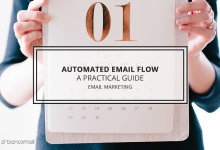Contents
- Don’t trap all your email’s call to action into an image
- To call to action or not to call to action
- The Call to Action must be simple and direct
- The Call to Action must emerge
- The Call to Action must be clicked
- The segmentation applies even for Call to Action
- The Call to Action’s 3 W: what, why, when
- Experience teaches
The goal of your email campaign, besides reaching the recipient’s inbox, is to encourage your reader to register to an event, to purchase a product or to request an information.
If you are able to make an effective call to action, then you are a step away from the result. Let’s see some CTA optimization tips.
Don’t trap all your email’s call to action into an image
Images and buttons are certainly able to attract more attention than words. These elements work very well in a website, a landing page or a form. However, if you’re using an email template, these could be not seen because of the readers block. And despite all, the alt text could hardly convince the reader to click. This is why avoid to associate your call to action only to images. Make sure to have a prominent text for each graphic call to action.
To call to action or not to call to action
More decisions you’ll ask your readers to take, unless they will. Minimise the clicks or actions that you expect your users carry out. Commonly, your DEM campaign needs to get one specific result, with some ways out.
The Call to Action must be simple and direct
Your creativity is certainly welcome, but be careful not to complicate with too many concepts or words your CTA or you’ll risk to lose appeal and attention. Your goal is not to make the reader think about your proposal, but to convince him in a few seconds.
Consider the call to action not as the place where to inform, but as the place where to use the few powerful words to lead your reader to the expected action.
The Call to Action must emerge
In the message, your CTA’s design must be very clear. It shouldn’t be hidden in a text block, but separated from the main text body and made it stand out from the background (there is nothing wrong if is white, as long as the CTA has what in technical jargon is called “margin”).
The Call to Action must be clicked
This is valid for every link of your contents, but it’s even more valid for the email’s most important link. Underline that the CTA is a link: inserting a call to action button is the main procedure, remember to use a font size larger than the main text, and if necessary, a bold. If you send a plain text message, highlight the CTA by using special characters.
Besides adding the call to action at the end of the message, make sure that at least one is visible in the foreword: it’s useful when(frequently) your reader doesn’t read the entire message.
The segmentation applies even for Call to Action
If the number of your audience is important, you’re probably already segmenting the sending list, so remember to update all the features of the message, including the call to action. Whenever you’ll make a call to action for a specific segment (demographic, for product category, for purchase behavior, etc) that will read your email, you will improve the performance.
Eg. Imagine the redemption with provincial segmentation where the call to action are of the type “Discover the offer to [your-city]”, despite the link points to the national catalog.
Even the dynamic customization variables improve the performance of an email campaign:
Es.
Generic CTA: “Discover these offers selected for you”
Dynamic CTA: “Francesca, discover the offers we have selected for you” or “Francesca, find out how to match [your-last-purchase]
The Call to Action’s 3 W: what, why, when
If you have a lack of creativity, remember that your CTA must answer at three questions: what is it? Why do I care? How can I get it?
Eg. Logical structure of the 3 CTA:
1. Save 50% to get the maximum from your marketing campaign by clicking here
2. Subscribe to our newsletter by entering your email here and get exclusive discounts
3. Download the guide here and learn how to maximize your marketing
Obviously, if we have learned the lessons of the previous points, the CTA must be keeped clear, concise and fleeting – collecting each response to the questions: what, why, when.
A good summary will be able to communicate directly to the reader’s brain the promotion’s benefits.
Eg. The 3 CTA reviewed:
1. Save 50% by clicking here
2. Sign-up for exclusive discounts
3. Download the guide to maximizing your marketing
Experience teaches
Enabling A / B tests and analysing to each submission, segment by segment, the redemption of the message will help you to understand what different features and what type of language (textual and visual) works better on your target.
The Call to Action is the most important part of your message. The time that you’ll take for the analysis of these data, will give you precious tips on how to get the best results.


 Email Marketing – Creating an automated Email flow
Email Marketing – Creating an automated Email flow Email Marketing: how to write Call To Action that work
Email Marketing: how to write Call To Action that work Email Marketing Database: every day a new deal
Email Marketing Database: every day a new deal